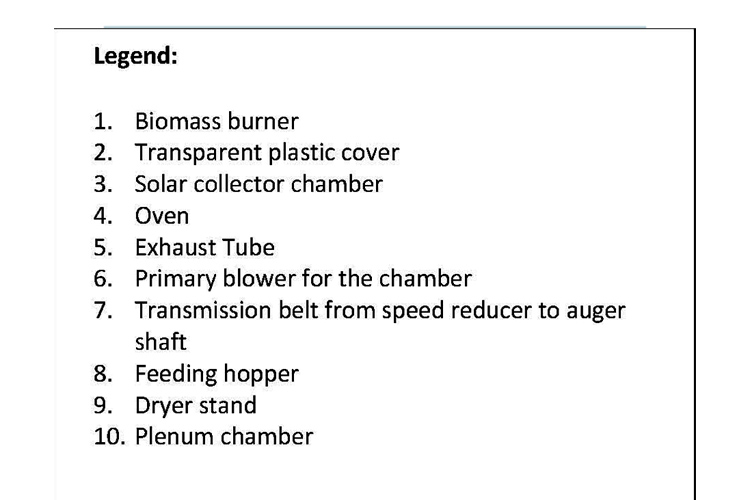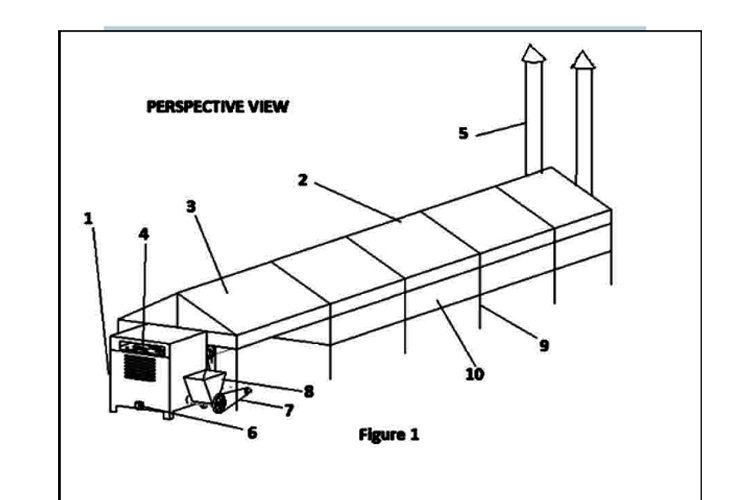Solar Dryer with Oven-Type Biomass Burner as Back-Up Heater
Patent Number: PH-1-2016-00148
Patent Title: Solar Dryer with Oven-Type Biomass Burner as Back-Up Heater
Description
A mechanical solar drying machine which dries different agricultural products using energy from the sun through the stones as heat collector and entraps to the drying chamber where the agricultural product is located. Simultaneously, a biomass burner ensures the continuous drying operation at the time when sunshine is not available. The biomass burner uses fire tubes as heat exchanger so that the product of combustion would not be in contact to the agricultural product. An oven is attached to the top of the biomass chamber to utilize the rejected and dissipated heat of the burner.
This seeder can be operated by a single person and has a capacity of 0.5 ha/h. It works as an attachment to a common hand tractor eliminating the drudgery of manual planting.
Innovative Features and Benefits:
Most of the existing dryers use convection mode of heat transfer wherein the air is heated to increase temperature and reduce humidity. This heated air is moved to the drying chamber to dry the agricultural product.
Convection mode of heat transfer is divided into two types, first is the natural convection wherein the air moves due to difference of temperature and buoyancy, and second is the forced convection wherein the mechanical device such as fan and blower are introduced to increase the velocity and flow rate of heated air which is one of the main factors to increase the drying rate.
This Solar Dryer with Oven-Type Biomass Burner as Back-Up Heater consists of three main parts: (1) the drying chamber, (2) the biomass chamber, and (3) the solar collector.
The drying chamber’s novel feature is the exhaust tube passes under the screen that further utilizes the heat from the flue gas before it will be released.
The three novel aspects of the biomass chamber are: (1) oven attached to the top of the burner to utilize rejected heat; (2) the fire tubes that serve as heat exchangers to avoid contamination of the commodity with the product of combustion, and (3) the centrifugal fan to suck and drive the heated air at the fire tubes to the drying area to increase drying rate.
The novel aspect of the solar collector is the addition of stones to increase the heat absorbing capacity, therefore, increasing the amount of heat to be delivered in the drying chamber.
Applications:
The Philippines is rich in agri-fishery products wherein drying is highly needed. Drying process increases the value of the commodity being dried such as fish and other marine species and several agricultural products such as mushrooms, cacao, coffee, mangoes and banana chips, including medicinal leaves, among others. Drying extends the shelf life of the product by reducing its moisture, thus, reducing the huge losses of agricultural products. Excess production of mangoes and other harvests can be dried leading to the prevention of wastage.
This Solar Dryer with Oven-Type Biomass Burner as Back-Up Heater dries various agricultural products even in the occurrence of sudden rain during the day. The drying process will not be interrupted since it has a biomass burner as back-up heater. The oven can also be used for another cooking means which increases the potential of this machine in the market.
Business Development Opportunity:
Measurement of the market size for this technology has not been pursued yet. However, fish-drying cooperatives, cacao and coffee industries are among the potential markets in Caraga and other parts of Mindanao.
Another potential market for this technology is the dried sea cucumber production. The Philippines is identified by the United Nations’ Food and Agriculture Organization (UN-FAO) as the “hotspot for sea cucumber fisheries in Asia”. Dried sea cucumbers are exported predominantly to China Hong Kong Special Administrative Region (SAR), Singapore, Republic of Korea, Taiwan Province of China and Japan.
This technology can also be potentially licensed to Philippine Center for Post Harvest Development and Mechanization (PhilMech) or to Davao TechnoCraft in Mindanao and other interested licensee in the Visayas and Luzon.
The prototype has been developed and is ready for mass scale production by potential licensee.
Interested in this IP?


